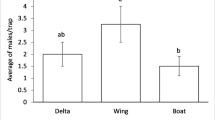Abstract
Preliminary observations were made in the attraction of moths of Chilo partellus Swin., Busseola fusca Fuller, Sesamia calamistis Hmps. and Maliarpha separatella Rag. to light traps and to traps baited with virgin females of these species. The observation was conducted from January 1981 to April 1982 at Mbita Point Field Station in western Kenya. M. separatella showed the highest attraction to light traps followed in descending order by C. partellus, E. saccharina, S. calamistis and B. fusca. The mean catches/trap/night in pheromone traps was highest for M. separatella, followed by C. partellus and B. fusca. The period of atttraction of the moths during the night and effect of moonlight on trap catches were also studied. Catches from light and pheromone traps indicated that attraction of C. partellus and M. separatella was greatest between 23:00 and 03:00hr. The effect of moonlight on light trap catches was greater than on pheromone trap catches.
Similar content being viewed by others
References
Anonymous (1979) Annual Report of WARDA (West Africa Rice Development Association). Monrovia, Liberia.
Anonymous (1980) Annual Report 1978/1979 of ICRISAT (International Crops Research Institute for the Semi-Arid Tropics). India: ICRISAT, Patancheru, A.P. 502324.
Anonymous (1981) Annual Report 1979/1980 of ICRISAT (International Crop Research Institute for the Semi-Arid Tropics). India: ICRISAT, Patancheru, A.P. 502324.
Bowden J. (1973a) The influence of moonlight on catches of insects in light-traps in Africa. Part I: The moon and moonlight. Bull. ent. Res. 63, 113–138.
Bowden J. (1973b) The significance of moonlight in photo periodic responses of insects. Bull. ent. Res. 62, 605–612.
Bowden J. and Church B. M. (1973) The influence of moonlight on catches of insect in light-traps in Africa. Part II: The effect of moon phase on light trap catches. Bull. ent. Res. 63, 129–142.
Bowden J. and Morris M. G. (1975) The influence of moonlight on catches of insects in light-traps in Africa. Part III: The effective radius of mercury-vapour light-trap and the analysis of catches using effective radius. Bull. ent. Res. 65, 303–348.
Breniere J. (1966) Dix anees de recherches sur les ennemis du riz on Afrique Francophone et a Madagascar. L’agro. Trop. 21, 514–519.
Breniere J. (1976) The principal insect pests of rice in West Africa and their control. West Africa Rice Development Association. Monrovia, Liberia.
Campion D. G., Bettany B. W., Nesbitt B. F., Beevor P. S., Lester R. and Popii R. G. (1974a) Field studies of the female sex-pheromone of the cotton leafworm Spodoptera litoralis (Boisd.) in Cyprus. Bull. ent. Res. 64, 89–96.
Campion D. G., Bettany B. W. and Steedman R. A. (1974b) The arrival of male moths of the cotton leafwork Spodoptera litoralis (Boisd.) (Lepidoptera, Noctuidae) at a new continuously recording pheromone trap. Bull. ent. Res. 64, 379–386.
Campion D. G. and Nesbitt B. F. (1981) Lepidopteran sexpheromones and pest management in developing countries. Tropical Pest Management 27, 53–61.
Chiang H. G. (1977) Pest management in the People’s Republic of China. Monitoring and forecasting insect population in rice, wheat and maize. Pl. Prot. Bull. F.A.O. 25, 1–8.
Garrido A., Lacassa A. and Rivero J. M. Del. (1979) Light traps as the service of entomological research. Intrinsic and extrinsic factors that qualitatively and quantitatively influenced the catches and the species of Lepidoptera taken in rice field in 1975. Anales del Instituto National de Investigaciones Agrarias, Protection Vegetal. 10, 105–126.
Harris K. M. (1962) Lepidopterous stem-borers of cereals in Nigeria. Bull. ent. Res. 53, 139–172.
Ingram W. R. (1958) The lepidopterous stalk-borers associated with Gramineae in Uganda. Bull. ent. Res. 49, 367–383.
Jepson W. F. (1954) A critical review of the world literature on the lepidopterous stalk-borers of tropical graminacceouscrops. London. Common W. Inst. Ent. 127 pp.
King E. W. and Hind A. T. (1960) Activity and dance in insect trap sampling. Ann. ent. Res. 53, 524–529.
Marks R. J. (1976) Mating behaviour and fecundity of the red bollworm, Diparopsis castanea Hmps. (Lepidoptera, Noctuidae). Bull. ent. Res. 66, 145–158.
Nesbitt B. F., Beevor P. S., Cork A., Hall D. R., Lester R., Blair B. W. and Tannock J. (1980) Identification of the female sex-pheromone of the maize stalk-borer, Busseola fusca: A preliminary note. Tropical Pest Management 26, 327.
Nye I. W. B. (1960) The Insect Pests of Graminaceous Crops in East Africa. Cotton. Res. Stud. No. 31, H.M.S.O., London, 48 pp.
William C. B. and Singh B. P. (1951) Effect of moonlight on insect activity. Nature, Lond. 167, 853.
Author information
Authors and Affiliations
Rights and permissions
About this article
Cite this article
Ho, D.T., Seshu Reddy, K.V. Monitoring of Lepidopterous Stem-Borer Population by Pheromone and Light Traps. Int J Trop Insect Sci 4, 19–23 (1983). https://doi.org/10.1017/S1742758400003982
Received:
Published:
Issue Date:
DOI: https://doi.org/10.1017/S1742758400003982



